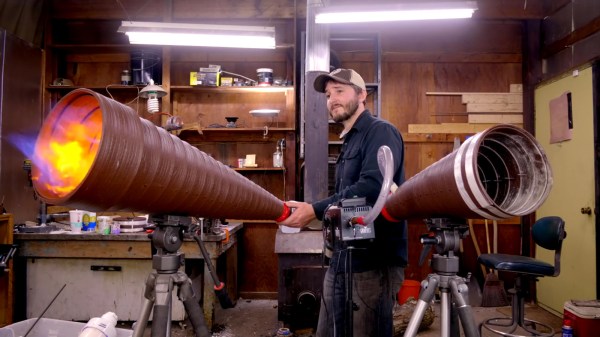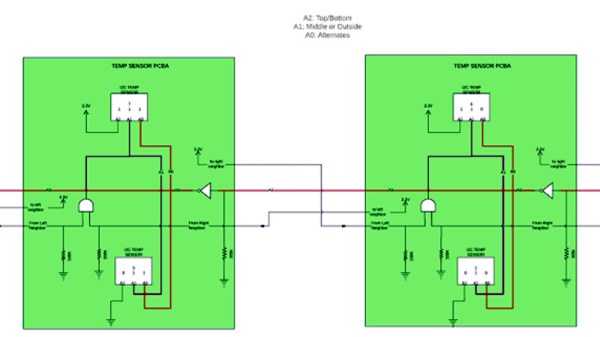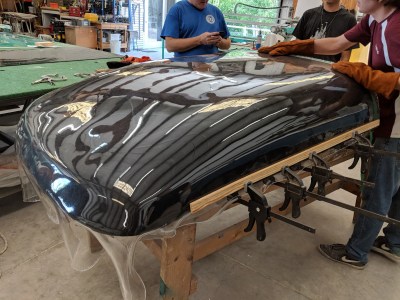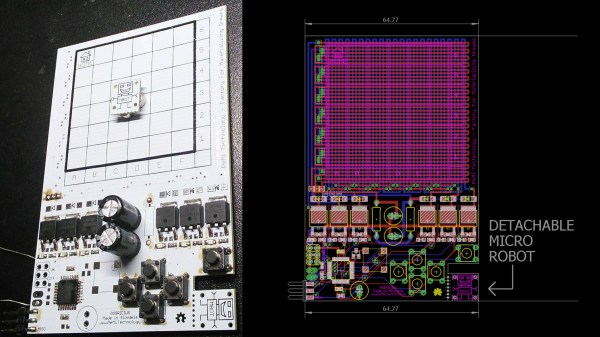In today’s healthy lifestyle oriented world, blowing smoke rings won’t impress too many people anymore. Unless of course you are [NightHawkInLight] and blow them with a vortex cannon and add lasers for visual effects. Although, his initial motivation was to build a device that could shoot lost frisbees out off the trees in his backyard disc golf course, and as avid enthusiast of shooting things through the air using a propane torch, he opted for a vortex cannon to avoid the risk of injuries shooting a projectile may cause.
With safety in mind from the beginning, [NightHawkInLight] chose to build the cannon in ways that won’t expose him or people following his footsteps to any toxic fumes. The barrel is formed by securing a roll of terrace board and simply pulling it into a cone. A series of PVC pipes and adapters build the combustion chamber that fits the terrace board barrel on its one end, and the propane torch nozzle on its other end. For easier aim and stability, he also adds a tripod mount.
Since air vortices are, well, air, and therefore not visible by themselves, they don’t offer the most visual excitement. [NightHawkInLight] solved this with a fog machine attached to the barrel, and a laser line module, which you can see for yourself in his build video after the break. In a previous vortex cannon project we could also see a more outdoorsy approach to add visibility to it.
Continue reading “Blowing Rings With Cannons, Fogs, And Lasers”




 It all starts with a cubic aluminum chassis designed to hold a mini-ITX motherboard. The top and side walls are essentially huge extruded heat sinks designed to efficiently carry heat away from inside the case. The heat is extracted and channeled away to the side panels via heat sinks embedded with sealed copper tubing filled with coolant fluid. Every part, from the motherboard onwards, needs to be selected to fit within the mechanical and thermal constraints of the enclosure. Using an upgrade kit available as an enclosure accessory allows [Tim] to use CPUs rated for a power dissipation of almost 100 W. This not only lets him narrow down his choice of motherboards, but also provides enough overhead for future upgrades. The GPU gets a similar heat extractor kit in exchange for the fan cooling assembly. A fanless power supply, selected for its power capacity as well as high-efficiency even under low loads, keeps the computer humming quietly, figuratively.
It all starts with a cubic aluminum chassis designed to hold a mini-ITX motherboard. The top and side walls are essentially huge extruded heat sinks designed to efficiently carry heat away from inside the case. The heat is extracted and channeled away to the side panels via heat sinks embedded with sealed copper tubing filled with coolant fluid. Every part, from the motherboard onwards, needs to be selected to fit within the mechanical and thermal constraints of the enclosure. Using an upgrade kit available as an enclosure accessory allows [Tim] to use CPUs rated for a power dissipation of almost 100 W. This not only lets him narrow down his choice of motherboards, but also provides enough overhead for future upgrades. The GPU gets a similar heat extractor kit in exchange for the fan cooling assembly. A fanless power supply, selected for its power capacity as well as high-efficiency even under low loads, keeps the computer humming quietly, figuratively.















